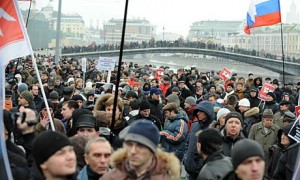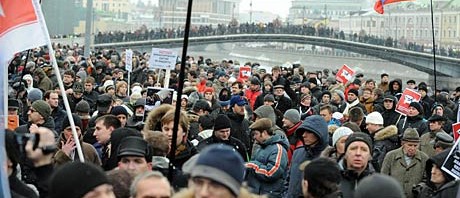Two years ago, the fair election protests were one of the most popular topics in the Russian media. But today they have been largely forgotten, and the nation’s attention is focused elsewhere. Meanwhile, arrests of Russian activists continue as before – activists who were, nevertheless, preparing for city-wide and municipal elections on September 14th, 2014. Could the September elections revive the Russian protest movement?

To answer this question, it’s important to pose another one: what, if anything, is left of the “Bolotnaya” movement? Have the fair election protests truly affected civil society? In studying the protest movement, we’ve observed a pattern rarely noted by other researchers: participants in the protest movement have united with the movement’s observers and commentators to form local activist groups, which strive to preserve the spirit of the movement and to direct its energies toward specific problems.
Many new activist groups emerged, independently of one another, in various districts of large Russian cities in the spring of 2012. There has been three main areas in which these civic associations are active: monitoring municipal authorities (attending municipal assemblies and tracking various legislative bills pursued by municipal administrations), informing residents (by publishing leaflets and newspapers dealing with local problems, the work of local administrations, and current political events), and improving their cities and public spaces (by pushing projects through municipal governments, defending threatened squares and parks, and combating road expansion). The groups then faced the internal crisis; some of them overcame it and recovered easily, others had to go through changes in their directions of activity, losses of activists etc. What are the causes of such crises? And what, in turn, might keep activists united in the long run? Why, despite the decline of protest movements, the waning of public attention, and numerous internal problems and disappointments, do these movements stubbornly continue with their “small tasks” (like the mole in the Krylov fable)?
Political Protests and City Activism
Researchers studying civil self-organization in the past decade in Russia have shown that people tend to join movements when they face issues that threaten their daily living: a park is suddenly destroyed, a building demolished, a salary reduced. But the activist groups we’ve described are comprised of people who first decided to join local initiatives, then selected problems to address. In other words, these people were motivated not by day-to-day issues, but by the desire to sustain collective action for its own sake, the desire to carry on the experiment of unity and solidary in which they first participated at the “Bolotnaya” protests.
Joining the protests had a significant effect on many people’s identities. For people who had been, for many years, wholly absorbed in their private lives, the protests were vivid and unforgettable. The sheer number of protesters and the similarities of their social profiles helped to create an atmosphere of community and like-mindedness.
It’s no accident that, in the effort to continue the work of activism, protesters chose local issues and a local frame of action. They wanted to offer concrete action as an alternative to the ‘protest for protest’s sake’ mindset. Continuity with the protest movement, and a divergence from it: these qualities characterize the new local movements.
Projects
Despite the impulse to solidarity and unity, initially the prerequisite to group collaboration was the preservation of individual negative freedom, or ‘freedom from’ – in this case, from the pressures and manipulations of other members:
“To be honest, I am not in favor of democratic centralism, where every person votes and then everyone does what the majority tells them to do, whether or not they themselves agree with it. All in all, we are a free organization. In other words, if somebody wants to do something, he does it. If not, he doesn’t.” (Computer programmer, born 1983)
This sort of thinking led new local initiatives to focus on completing projects, each devoted to a single issue. Usually, different projects attracted different sorts of participants: an activist’s role in a project was tied somehow to their area of expertise (doing what they can) and their preferences (doing what they believe is right). The ideal model for such an organization would be a community of equal individuals united by similar aspirations, who are all ready to work hard in order to realize concrete goals.
On The Way To Crisis
But group members hadn’t yet created rituals and practices that would allow them to maintain the initial feelings of unity that swept them up during the protests. Fear of losing personal freedom within collective action, along with limited resources and political inexperience, contributed to the crisis of local initiatives. Activists were focusing more and more on individual projects; they became less interested in the projects of other members, and in the activities of the group as a whole. In the words of one activist, “[now] everyone is waging their own little war.” (Energy Development worker, born 1981). This diffusion made activists feel under-appreciated for their contributions, and they began to tire of solitary work. As a result, activists in local movements grew more and more frustrated:
“I spent quite a lot of time [on group actions.] That’s one of the reasons I’ve stopped participating. If there were a lot of support coming [from other activists] and tangible evidence that we were growing, developing, then maybe I would have lasted longer. But at some point I saw that I was giving away a lot of my time, with very little results. There are other things I’d like to do in life.” (Literary publisher, born 1987)
Despite their initial closeness, members of local organizations often held quite different political views. A collective whose function is to unite individuals who are all free to act as they see fit does not necessarily commit itself to developing a common political stance or ideology. Conversations about social issues would sometimes exacerbate political disagreements, so members generally tried to avoid them. Moreover, group members worried that the basic nature of group discussion and action threatened their personal freedom – and, therefore, the enthusiasm that drives activist work. For instance one young woman was the coordinator of the big campaign within which the activists struggled against clear cutting of the public park. It was one of the main projects of the group which was time consuming and challenging campaign. That is why it activated the fundamental contradiction between desire to participate and fear of participation:
“Already once there was this problem that almost caused me to drop out from the park project. Because the group acted contrary to my ideas about what was needed, the ideas of many other people involved… It’s not that I was deciding there… In general it’s difficult for me to adapt to collective opinion. Not collective opinion, but the opinion of the majority.” (Lawyer, born 1983)
The Price of Freedom
Local activist groups were born from the euphoria of togetherness, but their crisis was a mounting skepticism about the effectiveness of collective action. The crisis had many causes: inadequate resources, political inexperience, a stagnant environment, a shortage of problems requiring immediate solutions. Though varying circumstances characterized the groups, they were all bound by a common mechanism of stagnation. Though initially inspired by a desire for group action, activists insisted on their right to demur from participation in group projects, so that they may preserve their independence and individuality. At the height of the crisis, group members not only denied the ideal of collective action, but even chose to forget their own sometime participation in any sort of collective:
“V: In your opinion, could one say that at this moment GO exists as a group? Are you a part of this group?
O: Well, I never imagined myself as a part of any group… I’m beginning to think that I might at one time have considered myself a part of a group. I’m not sure.” (private organizer, member of GO, born 1981)
The ethics of individualist participation refers both to the value of individual contribution and to the right of refusal. It confines the activist in a narrow space between two poles, in which the inverse to the participation impulse is the right to reject action if it seems to threaten individual freedom. Eventually the excitement of working together starts to fade, it becomes impossible for groups to coordinate projects, and members fall away from activism.
Freedom in Solidarity
The conflict between the impulse to solidarity and the fear of losing personal freedom is an important aspect of every local initiative we’ve studied. Still, we must add several qualifications. For one thing, this conflict does not affect all groups equally, not does it inevitably lead to crisis and collapse. Various other circumstances can help to smooth things over. Secondly, many new local initiatives have sprung up, and in some cases this conflict has become one of their driving forces. But in a time of political instability, in groups with little activist experience, a great deal depends on what sociologists call ‘agency’ – on the actions and creativity of individuals. For this reason, the internal conflict between competing values, goals, and ideals has such an impact on group dynamics.
The conflict described above is neither inevitable nor hopeless. During the Occupy Wall Street movement, activists consciously sought to create new forms of collectivity that could withstand the individualism that attends capitalist culture, while also respecting the personal freedoms of the activists. By experimenting with various forms of collectivity, like assemblies and working groups, activists realized their goal in various ways.
In the course of our investigation, we noted several approaches to organizing activist groups that helped to avoid or mitigate the conflict. For example, activists in one group freely elected a committee to coordinate actions and to reconcile individual and group projects. They created an organization that forced them to give up some particle of their freedom and independence, but to do it willingly, without outside coercion – since they themselves were the organization’s founders. Another example is Navalny’s group: its members acted independently, but they were still connected by a close-knit network and set of common goals, so that each individual action had the weight of a contribution to a larger project. This system allowed activists to experience the solidary of the original protest movement. They were connected enough to feel a sense of common purpose and mutual sympathy, but dispersed enough to avoid social pressures.
Now the lack of resources, demoralization of the protest movement and the repressions are great threatens for the local activism. But at the same time if we compare post-“Bolotnaya” Russia with post-Maidan Ukraine we will see that although the Maidan was much more radical and effective than the movement “For fair elections” Russian local activist group represent an good alternative to nationalistic mobilization of the society which adrenalizes the civil war. That is why it is needed to understand how to overcome not only external but also internal barriers and difficulties that hinder self-organization. From all this, one can draw a relatively simple conclusion: in a depoliticized society, where the most important resource is not money or institutions but people themselves, civil society can emerge only when people overcome the fear and stigmatization of collectivity – when they exchange the habits of the private sphere for the skills of collective action, and begin to find in solidarity not coercion but a kind of freedom.
(translated from Russian by Helen Tsykynovska)
Laboratory of Public sociology (PS Lab) is an autonomous project of young researchers based on Center for Independent Social Research. PS Lab is the new incarnation of a research group “Politicization Researchers Collective” where scholars from different fields studied Russian protests in 2011-2012. More information on their website.

